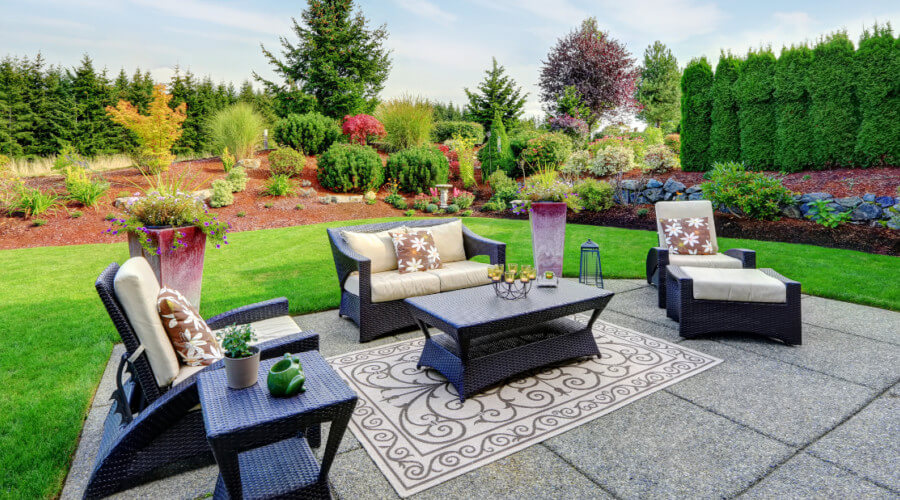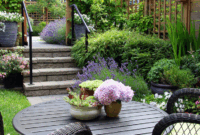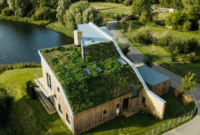Transforming your outdoor space into a lush and relaxing haven doesn’t have to be expensive or complicated. With the right gardening hacks, a touch of creativity, and consistent care, anyone can turn a small backyard into a peaceful retreat. Whether you’re a beginner or an experienced gardener, these backyard gardening ideas will help you create the perfect balance between beauty and functionality in your outdoor space.
From smart garden tips to affordable design tricks, let’s explore how you can create your very own backyard oasis that feels luxurious yet easy to maintain.
1. Plan Your Backyard Layout Before You Plant
The first step in successful backyard gardening is planning. A well-thought-out layout ensures you make the most of your space while keeping it visually appealing. Start by sketching your garden area, marking spots for plants, seating, and pathways. Decide if you want a minimalist modern vibe, a cottage garden, or a tropical paradise.
Consider how sunlight moves through your backyard during the day — most plants need at least six hours of sun. Use a mix of perennials and annuals to create depth and color throughout the year. Online tools like Garden Planner by Almanac can help you visualize your design before you begin.
Internal link suggestion: Learn how smart tech can simplify your garden in How to Create a Fully Automated Smart Garden in 2025.
Pro Tip: Group plants with similar sunlight and watering needs together to make maintenance easier and prevent overwatering or dehydration.
2. Start Small and Build Gradually
Many new gardeners get excited and try to plant everything at once — a common mistake. One of the best gardening hacks is to start small. Focus on one area, such as a flower bed, vegetable patch, or patio garden. Once you’ve mastered maintaining that, expand your space gradually.
Raised garden beds are a great place to start for beginners. They offer excellent drainage, reduce weed growth, and make it easier to manage your plants. Check out Gardener’s Supply Company for affordable raised bed kits that fit all yard sizes.
Adding mulch is another easy garden tip. It helps retain moisture, keeps weeds under control, and adds a polished look to your garden. Organic mulch, such as wood chips or shredded bark, also improves soil quality over time.
Pro Tip: Don’t be afraid to experiment. Some of the most beautiful gardens evolve over seasons of trial and error.
3. Choose Low-Maintenance, High-Impact Plants
To create a stunning garden without spending hours maintaining it, focus on low-maintenance plants that thrive in your local climate. For backyard gardening, opt for native plants — they’re adapted to local conditions and require less water and fertilizer.
Popular low-maintenance plants include lavender, succulents, hostas, and ornamental grasses. If you love color, consider perennials like echinacea, black-eyed Susans, or hydrangeas, which bloom beautifully year after year. For shaded areas, ferns and caladiums add rich texture and contrast.
Online resources like Gardenista or Better Homes & Gardens Gardening Section offer plant guides for different climates and garden styles.
Pro Tip: Incorporate evergreens to ensure your garden stays vibrant even in the off-season.
4. Incorporate Water Features for a Relaxing Ambiance
Nothing says “oasis” quite like the sound of trickling water. Adding a water feature is one of the most effective gardening hacks for creating a relaxing backyard atmosphere. You don’t need a massive pond or fountain — small solar-powered water features or tabletop fountains can bring the same calming effect.
Try installing a small birdbath or a recirculating fountain. These additions attract birds, butterflies, and bees, making your garden feel more alive and connected to nature. Explore options at Wayfair Outdoor Fountains for budget-friendly designs.
Pro Tip: For a modern touch, use black stone or concrete fountains surrounded by greenery for contrast and elegance.
5. Use Smart Gardening Tools and Automation
Thanks to modern technology, you can maintain your backyard oasis effortlessly. Smart tools are among the most innovative gardening hacks today. From self-watering planters to Wi-Fi-controlled sprinklers, automation saves time and ensures your garden thrives even when you’re busy.
Consider using smart irrigation systems like Rain Bird Smart Irrigation or Orbit B-hyve that adjust watering schedules based on weather forecasts. Pair these with soil moisture sensors to avoid overwatering.
Internal link suggestion: Read our detailed guide on Smart Home Technology Integration: The Future of Living to learn how to connect these systems with your home network.
Pro Tip: Solar-powered lights and sprinklers help you save energy while maintaining a sustainable garden setup.
6. Add Outdoor Lighting to Extend Your Evenings
Outdoor lighting is both functional and decorative. The right lighting can make your backyard usable even after sunset while creating an enchanting mood. Use LED string lights, lanterns, or solar-powered garden stakes to highlight walkways and plants.
Warm-toned lights help create a cozy and inviting ambiance. Try Home Depot Outdoor Lighting or Lamps Plus for affordable lighting options.
Pro Tip: Use uplighting to highlight trees and architectural features, while soft pathway lights ensure safety and elegance.
7. Create a Functional Outdoor Living Space
For many, the goal of backyard gardening isn’t just beauty — it’s functionality. Incorporate a comfortable seating area with weatherproof furniture, add a pergola or shade sail for comfort, and include a small dining area for outdoor meals.
Use natural materials like wood, rattan, and stone to blend your furniture with the environment. Add colorful cushions and throws for a touch of personality. For those on a budget, check out IKEA Outdoor Furniture or Target Patio Collections.
Pro Tip: Include portable fire pits or outdoor heaters to make your backyard oasis usable year-round.
8. Use Recycled Materials and DIY Projects
If you love creative gardening hacks, repurposing materials is a must. You can transform everyday items into unique garden décor. Use old wooden crates as planters, paint discarded tires for colorful flower beds, or turn pallets into vertical gardens.
DIY projects save money and allow you to customize your garden design. Platforms like Pinterest and Houzz offer thousands of ideas for budget-friendly garden crafts and furniture.
Pro Tip: Upcycling also supports sustainable living — a perfect match for eco-conscious gardeners.
9. Maintain Your Garden Regularly
The secret to a thriving garden isn’t just planting — it’s consistency. Regular maintenance keeps your backyard gardening looking its best. Schedule weekly tasks like pruning, watering, and fertilizing. Remove weeds early before they spread.
Use natural fertilizers such as compost or worm castings for better soil health. Composting kitchen waste not only reduces your carbon footprint but also enriches your soil naturally. Learn more about composting basics from EPA’s Composting Guide.
Pro Tip: Keep a gardening journal to track what works best for your plants each season.
Final Thoughts: Your Backyard Oasis Awaits
Creating a backyard oasis doesn’t require a massive investment — just creativity, consistency, and a love for nature. With these garden tips and practical gardening hacks, you can build a space that reflects your style, promotes relaxation, and supports sustainability.
Whether it’s through low-maintenance plants, smart automation, or simple DIY décor, your backyard gardening journey can be both rewarding and therapeutic. Start small, nurture your plants, and enjoy watching your dream oasis flourish season after season.
Remember: A beautiful garden is never truly finished — it evolves with you, growing richer and more vibrant each year.




